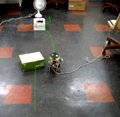 It’s a crude schoolroom axiom around which many an adult pub debate might also revolve: He who smelt it, dealt it.
It’s a crude schoolroom axiom around which many an adult pub debate might also revolve: He who smelt it, dealt it.
However, there is a serious side to quickly locating the source of noxious odours in an indoor environment of varying airflow, as Zhenzhang Liu and Tien-Fu Lu of The University of Adelaide, Australia, will attest. They are developing an insect-like robot capable of odour plume tracing that could be used to detect toxic gas leaks, identify the source of a fire, or uncover cached explosives.
“The recent increasing threat of chemical weapons technologies has highlighted the need for superior detection of hazardous emission sources,” the researchers explain, “One promising area of technological development is odour source detection using plume-tracing robots.” Such devices would be able to trace toxic emissions without putting personnel in danger.
The team explains how odours require a complicated search and find approach, something that sniffer dogs and insects seem to be very good at but that has been impossible to emulate with technology. An odour released into a seemingly still environment will diffuse through the air but airflow from open windows, swinging doors, people moving around and working equipment, will quickly influence the motion of any odour molecules, leading to the formation of a complex, twisting plume rather than a cartoonish cloud of odour.
Liu and Lu integrated two control algorithms to endow the robot with odour-tracing skills. The first is the fundamental wall-following collision avoidance algorithm that allows the robot to make its way around a building. The second taps into built-in odour sensors and uses the so-called anemotaxis, or plume-tracing, algorithm, based on insect behaviour, to follow a scent.
 The team used ultrasonic sensors for obstacle detection, airflow sensors for monitoring air movements, and ion detectors for sensing the odour plume. Working together, the two algorithms allow the robot to trace odour plumes even in an obstructed building environment.
The team used ultrasonic sensors for obstacle detection, airflow sensors for monitoring air movements, and ion detectors for sensing the odour plume. Working together, the two algorithms allow the robot to trace odour plumes even in an obstructed building environment.
The robot was able to track an odorous plume and avoid obstacles even in a room with a disturbed airflow, but did so, not surprisingly, and much more slowly than any insect. Nevertheless with optimisation of the algorithms and improved sensor and detector technology one can envisage that the next prototype will be a lot speedier. It is doubtful though whether it will ever be quite as fast as those who adhere to the “smelt it, dealt it axiom”, however.
![]() Zhenzhang Liu, & Tien-Fu Lu (2009). Odour source localisation in a wind-varying indoor environment Int. J. Mechatronics and Manufacturing Systems, 2 (1/2), 168-186
Zhenzhang Liu, & Tien-Fu Lu (2009). Odour source localisation in a wind-varying indoor environment Int. J. Mechatronics and Manufacturing Systems, 2 (1/2), 168-186